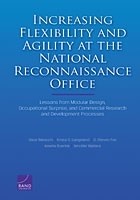| 来源类型 | Research Reports
|
| 规范类型 | 报告
|
| ISBN | 9780833081025
|
| 来源ID | RR-336-NRO
|
| Increasing Flexibility and Agility at the National Reconnaissance Office: Lessons from Modular Design, Occupational Surprise, and Commercial Research and Development Processes |
| Dave Baiocchi; Krista Langeland; D. Steven Fox; Amelia Buerkle; Jennifer Walters
|
| 发表日期 | 2013
|
| 出版年 | 2013
|
| 页码 | 88
|
| 语种 | 英语
|
| 结论 |
On Modularity, Response to Surprise, and Promotion of Organizational Innovation, the Authors Reached the Following Conclusions- Modularity provides flexibility, but at a cost.
- There are different classes of modular systems, where each class provides different levels of functionality and up-front costs.
- Based on a set of criteria that RAND researchers developed to gauge the suitability of a particular system toward modularity, National Reconnaissance Office space systems do not appear to be strong candidates for modularization.
- Tacticians, who must generally react within seconds or minutes, often must first overcome fear and anxiety. A typical protocol is to control panic, buy time, and then revert to fundamentals learned in training.
- Strategists, who have days or weeks to react, generally face immediate feelings of anger and an impulse to overreact. A similar process for coping is employed: control emotions, take some initial enabling actions, quickly assemble key staffers, and disseminate a coherent longer-term response.
- The level of chaos in the environment also affects people's response to surprise.
- The most complex and chaotic situations are caused by other humans, rather than something in the environment.
- The biggest surprises tend to come from third parties.
- Innovation occurs for many reasons, each requiring a different approach.
The Authors Observed Three Common Lessons in These Disparate Topics- Modularity and innovation are not goals in themselves.
- Strategic planning would be beneficial for all three areas discussed.
- Solutions in all three areas require not just hardware, but also people and organizational structures.
|
| 主题 | Business Strategies
; Decisionmaking
; Intelligence Collection
; Satellites
; United States
|
| URL | https://www.rand.org/pubs/research_reports/RR336.html
|
| 来源智库 | RAND Corporation (United States)
|
| 资源类型 | 智库出版物
|
| 条目标识符 | http://119.78.100.153/handle/2XGU8XDN/107567
|
推荐引用方式
GB/T 7714 |
Dave Baiocchi,Krista Langeland,D. Steven Fox,et al. Increasing Flexibility and Agility at the National Reconnaissance Office: Lessons from Modular Design, Occupational Surprise, and Commercial Research and Development Processes. 2013.
|
|
文件名:
|
x1495315143587.jpg
|
|
格式:
|
JPEG
|

|
文件名:
|
RAND_RR336.pdf
|
|
格式:
|
Adobe PDF
|
除非特别说明,本系统中所有内容都受版权保护,并保留所有权利。